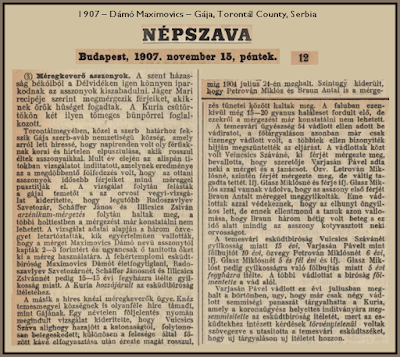FULL TEXT: It is very easy for women to get rid of the hiccups of holy marriage in the South. According to the recipe of Mari Jáger [the famous 1897 case], they poison their husbands, to whom they have received eternal allegiance. The Court dealt with two such mass crimes on Thursday.
In Torontál County, close to the Serbian border, is a Serbian-Swabian village of Gaja, which became famous for the early and sudden deaths of men who had abused their women on the agenda. Earlier this year, the Deputy Lieutenant secretly launched an investigation that resulted in the shocking discovery that the women there destroyed their older husbands with poison.
The investigation excavated the Gaja cemetery and the medical chemical examination revealed that Radoszavlyev Svetozar, János Scháffer and Zsivá Illicsics had recently died of arsenic poisoning. Based on the data of the investigation, the three widows were arrested, who clearly testified that they had received the poison from a woman named Dámó Maximovics for 2-3 forints, and she also taught her how to use the poison.
The jury sentenced Dámót Maximovly, Jánosnet Scháffer and Zsivánné Illicsics to 15 years in prison for murder. The Court agreed to the jury's verdict.
Similar is the case of the famous Knez poisoners. The village of Knez County in Timisoara also had the same reputation as Gaja. An investigation following an anonymous report revealed that Sara Vuicsics had barely returned home from the military, was constantly ill, especially after consuming coffee cooked by his wife, and felt ill on July 24, 1904. It also turned out that Mrs. Miklós Petrov and Antal Braun from symptoms of the poisoning. There were also 15 to 20 suspected deaths in the village, but no further poisoning could be detected.
It also turned out that Miklós Petrován and Antal Braun died among the symptoms of the mutilation. There were also 15 to 20 suspected deaths in the village, but no further poisoning could be detected.
The Timisoara prosecutor's office filed indictments against 54 defendants, but there were only eleven defendants at the main trial, and the others were dropped for lack of evidence.
Among the defendants was Sáváné Veincsics, who had poisoned her husband, confessing that her lover, Varjaán Pável, had given her the poison and advice.
Mrs. Miklós Letrován also poisoned her husband, but she denied her actions. Mrs. Miklós Glaz is accused of murdering the woman's first husband, Antal Braun, with poison.
These savages defend themselves by claiming that the deceased committed suicide, but this is contradicted by the testimony of the witnesses that Braun was ill for three weeks and during which time the woman always gave him medicine.
The court of jury in Timisoara gave 15 years sentence for murder to Mrs. Sává Vuicsics, 10 years to Mrs. Pável Varjas as an instigator, 6 years to the widow Mrs. Miklós Petrován, 5 and a half years to Mrs. Miklós Glasz, plus 5 years in prison to Mrs. Glasz for incitement to murder. The other defendants were acquitted by the court.
Defendant Pável died in prison in July this year, so that only four defendants could hear the nullity of four defendants, which annulled the jury's verdict on the motion of the deputy crown prosecutor, because the questions to the jurors were illegally worded and instructed make a new judgment.
[“Poison-mixing women.” (“Méregkeverő asszonyok.”) Népszava (Budapest, Hungary), Nov. 15, 1907, p. 12]
***
Torontál (Hungarian: Torontál, German: Torontal, Serbian: Торонтал, Romanian: Torontal) was an administrative county (comitatus) of the Kingdom of Hungary. Its territory is now divided between Serbia and Romania, except a small area which is part of Hungary. The capital of the county was Nagybecskerek (Serbian: Велики Бечкерек, German: Großbetschkerek, Romanian: Becicherecu Mare), the current Zrenjanin. Torontál county was located in the Banat region. It shared borders with the Kingdom of Serbia and the Hungarian counties Syrmia, Bács-Bodrog, Csongrád, Csanád, Arad and Temes (the first county was part of Croatia-Slavonia). The river Danube formed its southern border, the river Tisza its western border, and the river Maros (Mureș) its northern border. Its area was 10,042 km² around 1910.
***
FULL TEXT: A szent házasság békóiból a Délvidéken igen könnyen iparkodnak az asszonyok kiszabadulni. Jáger Mari recipéje szerint megmérgezik férjeiket, akiknek örök hűséget fogadtak. A Kuria csütörtökön két ilyen tömeges bünpörrel foglalkozott.
Torontálmegyében, közel a szerb határhoz fekszik Gája szerb-sváb nemzetiségű község, amely arról lett híressé, hogy napirenden volt oly férfiaknak korai és hirtelen " elpusztulása, akik rosszul éltek asszonyaikkal.
Mult év elején az alispán titokban vizsgálatot indíttatott, amelynek eredménye az a megdöbbentő fölfedezés volt, hogy az ottani asszonyok idősebb férjeiket mind méreggel pusztítják el.
A vizsgálat folytán felásták a gájai temetőt s az orvosi vegyi-vizsgálat kiderítette, hogy legutóbb Radoszavlyev Szvetozár, Scháffer János és Illicsics Zsiván arzénikum-mérgezés folytán haltak meg, a többi holttestben a mérgezést már konstatálni nem lehetett.
A vizsgálat adatai alapján a három özvegyet letartóztatták, kik egyértelműen vallották, hogy a mérget Maximovics Dámó nevü asszonvtól kapták 2—3 forintért és ugyancsak ő tanitotta dket ki a méreg használatára.
A fehértemplomi esküdtbíróság Maximovics Dámót életfogytiglani, Radoszavlyev Szvetozárnét, Scháffer Jánosnet és Illicsics Zsivánnét pedig 15—15 évi fegyházra Ítélte gyilkosság miatt. A Kúria hozzájárult az esküdtbíróság itéletehez.
A másik a hires knézi méregkeverők ügye. Knéz temesmegyei községnek is olyanféle híre támadt, mint Gájának. Egy névtelen följelentés nyomán megindult vizsgalat kiderítette, hogy Vuicsics Szára alighogy hazajött a katonaságtol, folytonosan betegeskedett, különösen a felesége által főzött káve elfogyasztása után érezte magát rosszul, mig 1904 julius 24-én meghalt. Szintúgy kiderült, hogy Petrován Miklós és Braun Antal is a mergezés tünetei között haltak meg. A faluban ezenkívül még 15—20 gyanús halaleset fordult elő, de ezekről a mérgezést már konstatálni nem lehetett.
A temesvári ügyészség 54 vádlott ellen adott be vádiratot, a főtárgyaláson azonban már csak tizenegy vádlott volt, a többiek ellen bizonyíték hijján megszüntették az eljárást.
A vádlottak közt volt Veincsics Száváné, ki férjét mérgezte meg, bevallotta, hogy szeretője Varjasán Pável adta neki a mérget és a tanácsot.
Özv. Letrován Miklósné, szintén férjét mérgezte meg, de váltig tagadta tettét. fj. Glasz Miklosné és férje ifj. Glasz Miklós azzal vannak vádolva, hogy az asszony első férjét Braun Antalt méreggel meggyilkolták.
Eme vadlottak azzal védekeznek, hogy az elhunyt öngyilkos lett, de ennek ellentmond a tanuk azon vai llomása, hogy Braun három hétig volt beteg s ez idő alatt mindig az asszony kotyvasztott neki orvosságot.
A temesvári esküdtbíróság Vuicsics Szávánét gyilkosság miatt 15 évi, Varjasán Pávelt mint fölbujtót 10 évi, özvegy Petrován Miklósnét 6 évi, ifj. Glasz Miklósnét 5 és fél évi és ifj. Glasz Miklóst pedig gyilkosságra való fölbujtás miatt 5 évi fegyházra itelte.A többi vádlottat a biróság fölmentette a vád alól.
Varjasán Pável vádlott ez évi juliusban meghalt a börtönben, ugy, hogy már csak négy vádlott semmiségi panaszát tárgyalhatta a Kúria, amely a koronaügyész helyettes indítványára megsemmisítette az esküdtbíróság ítéletét, mert az esküdtekhez intézett kérdések törvénytelenül voltak szövegezve s utasította a temesvári esküdtszéket, hogy uj tárgyaláson uj Ítéletet hozzon.
[“Méregkeverő asszonyok.” Népszava (Budapest, Hungary), Nov. 15, 1907, p. 12]
***
***
***




No comments:
Post a Comment